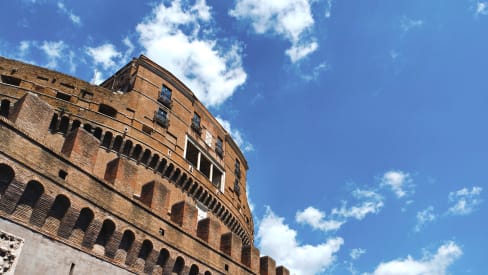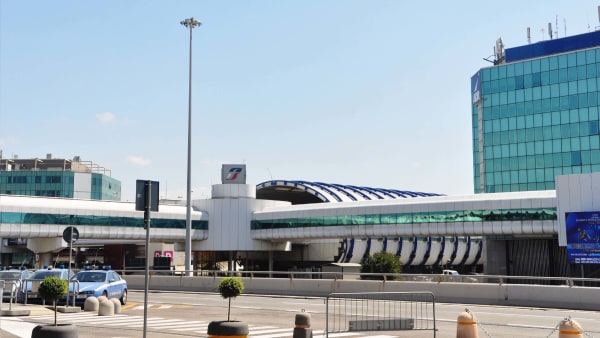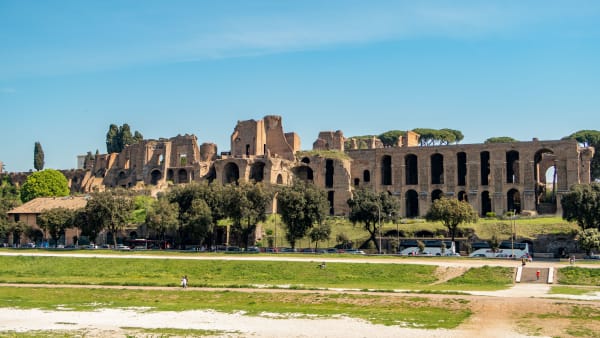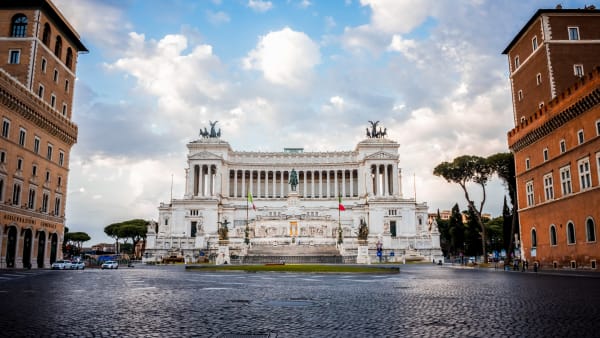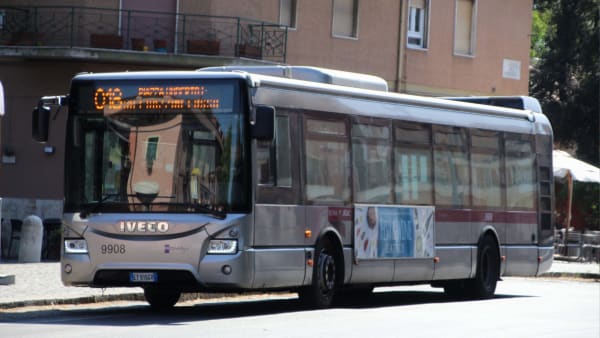Brief history
Brief history
The castle attracts more than a million visitors each year. The circular structure is surrounded by massive walls and stands 48 meters above the ground. A visit to this place is an exciting journey through time dating from 2,000 years ago to the present.
The building which we know today as a world-famous museum, previously had the function of a monumental tomb, fortress, prison, private residence, and military headquarters.
Imperial period (27 BC - 476 AD)
The great Mausoleum of Hadrian was built between 123 and 139 AD under the direction of the architect Decrianus. It was inspired by the Mausoleum of Augustus but with larger dimensions. To connect the building to Campus Martius on the other side of the Tiber, the Pons Aelius (now called the St. Angelo Bridge or Bridge of Angels) was opened in 134.
The original mausoleum consisted of a square space 83 meters wide and 15 meters high. It was lined with marble on the outside, and the frieze was decorated with ox heads (bucrania) and festoons (also called garlands). On top of this was a cylindrical building with a diameter of 64 m and a height of 21 m. Above the cylinder was a tower with three burial chambers, which has now been incorporated into the newer parts of the building.
After Hadrian’s death, his successor Antoninus Pius continued the work and the mausoleum eventually became the final resting place of several emperors and their families. Among them:
- Hadrian and his wife Vibia Sabina
- Antoninus Pius, his wife Faustina Major and three of their children
- Lucius Aelius Caesar
- Commodus
- Marcus Aurelius and three of his sons
- Septimius Severus, his wife Julia Domna and their sons
- Geta
- Caracalla
At the top where the statue of the archangel now stands, there was probably a bronze statue of Emperor Hadrian as a sun god pulled by a quadriga. The perimeter of the monument was surrounded by statues, the remains of which have been preserved to this day. The most intact of these is the famous Barberini Faun. There was also a wall around the perimeter with a bronze gate decorated with peacocks.
Medieval era (476 - 1492)
In 403 AD, after the numerous incursions of barbarians and looters into the city, the mausoleum started to be used as a fortress.
By order of the western emperor Honorius, it was connected to the Aurelian Walls to become part of the city’s defense system.
Thus, the fortress protected the Vatican from the plundering by the Vandals of Genseric in 455. The Romans then decided to counterattack with literally everything at their disposal. Even the aforementioned statue, the Barberini Faun, was thrown at the enemies.
In the early sixth century, the building was used by Theodoric as a state prison.
It’s said that the castle received its current name in 590. At that time, the city was hit by the plague, until one day something miraculous happened. According to legend, Pope Gregory I saw in a vision how archangel Michael on top of the castle slipped his sword back into its sheath as a sign that the epidemic had ended. More details on the origin of the castle’s name can be found later in this article.
Later in this period, many families competed for ownership of the castle including the senator Theophylactus and his family—who also used it as a prison—and the Crescenzi family, who fortified the castle and named it Castrum Crescentii.
In 1277, Pope Orsini Niccolò III ordered the construction of the Passetto di Borgo, an escape route connecting the Apostolic Palace in Vatican City with Castel Sant’Angelo. He also decided to partially transfer the Holy See there.
Later the castle came into the hands of the Pierleoni and Orsini families, who ceded it to the Church in 1365.
In 1367, the keys to the building were handed over to Pope Urban V. From that moment on, especially after its destruction by a French garrison, Castel Sant’Angelo linked its fate to that of the popes. Because of its fortified structure, the popes used it as a refuge in times of danger, to house the Vatican archives and treasury, as a court, and as a prison.
After the reconstruction commissioned by Pope Boniface IX in 1395, the castle regained its former function. The Pope commissioned the military architect Nicolò Lamberti to carry out several works to strengthen the defensive structure of the castle. The shape of the entrance to the building was redefined and the chapel dedicated to Archangel Michael was rebuilt.
Renaissance (1492 - 1789)
Throughout the 16th century, the castle’s defenses were improved and the halls were decorated more and more beautifully. Architect Antonio da Sangallo the Younger (known from Saint Peter’s Basilica) was partly responsible for this. It seems that Pope Alexander VI had a new part built, transforming the castle into a place for banquets and performances, which was demolished by Pope Urban VIII in 1628. Remarkably, the part in question was painted by the famous Pinturicchio.
However, it was the fortification works of Pope Alexander VI that enabled Pope Clement VII to withstand the siege of the famous Landsknechte for seven months. Examples were the construction of four pentagonal bastions, dedicated to the Evangelists, and the moat dug around the walls filled with the water of the Tiber.
On May 6, 1527, the army of 25,000 German and Spanish soldiers led by Charles V took over the city. During the Sack of Rome, nothing or no one was safe. Destruction, robbery, rape, and murder took place. In addition, a new plague epidemic broke out. In the end, 20,000 citizens were killed, 10,000 fled and 30,000 died from the plague brought by the invaders.
However, a small part of the population at the time (of the 50-60 thousand in total) and Pope Clement VII himself were able to reach the Castel Sant’Angelo for shelter via the Passetto di Borgo. On June 7, 1527, the pope surrendered and was forced to open the fortress to the enemy. In 1530 he was obliged to crown Charles V as emperor.
Between 1667 and 1669, after further renovations, Clement IX had the ten famous marble angels placed on the Pons Aelius. Since then, it has also been called the St. Angelo Bridge. In the 19th century, the castle was used exclusively as a political prison and was known as Fort Sant’Angelo.
Contemporary age (1789 - present)
During the Napoleonic era, when Rome was occupied by the revolutionary army, Pius VI Braschi (1775-1799) was forced into a humiliating exile and the garrison stationed in the castle surrendered. The powder magazines were handed over, the documents of the Vatican Apostolic Archives were sealed with the papal coat of arms, and the papal banner was replaced with the French tricolor.
Even the bronze statue of the archangel was painted in the three French national colors, was proclaimed the “Genius of the Liberation of France” and a red Phrygian cap was placed on his head. All the papal coats of arms affixed to the walls of the fortress and the ramparts, as a reminder of the work done over the centuries, were removed.
When French troops withdrew from Rome in October 1799, the flag of the Kingdom of Naples was placed on the fortress. It remained there until the castle was returned to the army of Pope Pius VII (1800-1823).
Upon their departure from Castel Sant’Angelo, the Bourbon soldiers emptied the storerooms, took artillery and ammunition, furniture and upholstery, and even removed the glass from the windows, the doors, and water pipes. All that remained of the castle was the prison and a base for the troops to defend it.
After the creation of the Kingdom of Italy in 1861, the fortress was initially used as a barracks, then converted into a museum. The castle has seen a succession of different restoration works. Those of 1886-1887, for example, were necessary for the construction of the new banks of the Tiber and were entrusted to two officers of the Genio Militare, Mariano Borgatti, and Enrico Rocchi.
The major renovations in Castel Sant’Angelo and its surroundings continued through the early 20th century. Until 1911 when the World Exhibition dedicated to art and culture was held in Rome. Between 1914 and 1915, the process of demilitarization of the castle was completed, with the castle being definitively assigned to the Ministry of Education, while only the surrounding area remained with the Ministry of War.
During World War I, works of art from the war zones were stored in the fortress, including bronze horses from the Basilica of San Marco in Venice. In the years between the wars, the idea of isolating the majesty of the castle in the city gardens prevailed. The result was the demolition of all the structures that had been built in the area over the centuries and the destruction of even more historical documents about the complex history of the fortress.
The building’s long and varied history, with its countless transformations, seems to have nestled in the intricate labyrinth of underground corridors, dwellings, loggias, staircases, and courtyards that make up the castle’s current layout. Today, it’s a multifaceted and complex structure, full of symbolic values and historical layers. In 2019, the museum was visited by 1.2 million people, ranking it among the top five most visited museums in Italy.


